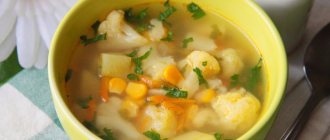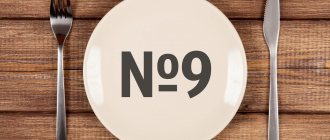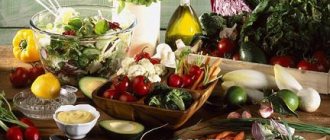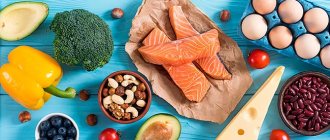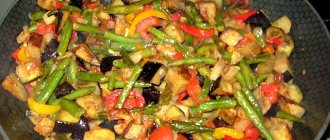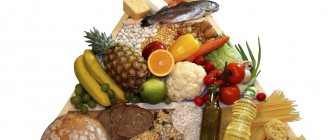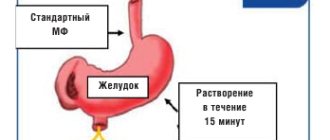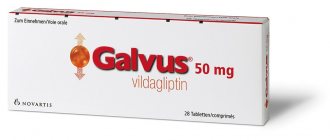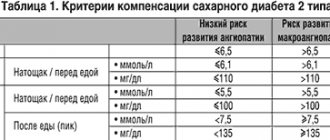Diabetes mellitus does not have clearly defined degrees that can be expressed by numerical indices. Usually there are mild, moderate and severe degrees of the disease. But there are two types of this disease - the first type (insulin dependent) and the second type (non-insulin dependent).
It is especially important for such patients to adhere to the rules of rational nutrition, since in this case it is the correction of the diet that is the main method of treatment.
Features and principles of nutrition for type 2 diabetes mellitus
Type 2 diabetes mellitus causes a drop in glucose concentration and a lack of energy in the cells of the spinal cord due to insufficient supply of glucose to the cells of the patient’s body. Diabetes mellitus of this type develops in elderly or mature people and is directly related to the aging of the body or obesity. The task of a person with type 2 diabetes is to lose weight, then he will get rid of the disease. Losing 5 kg of weight will greatly improve insulin levels in the blood, so you should follow a low-calorie diet.
The main energy in the human body during nutrition comes from proteins, fats and carbohydrates. Fats contain more energy, almost twice as much as carbohydrates or proteins, so an effective low-calorie diet for type 2 diabetes would be a significant reduction in fat in the menu.
To remove as much fat as possible, you should follow several dietary rules:
- Remove fat from meat and skin from poultry before cooking.
- Carefully read the information on the product packaging, it will show the fat content.
- Avoid frying foods in vegetable oil. It is better to use stewing, baking or boiling.
- Adding mayonnaise or sour cream to salads significantly increases their calorie content.
- Try to eat more raw vegetables than cooked ones.
- Avoid chips and nuts - they are high in calories.
Some features of optimal nutrition for diabetics
- In no case should you neglect breakfast.
- You can’t go hungry and take long breaks from eating.
- Last meal no later than 2 hours before bedtime.
- Dishes should not be too hot or too cold.
- During meals, vegetables are eaten first, and then a protein product (meat, cottage cheese).
- If a portion of food contains a significant amount of carbohydrates, there must also be proteins or the right fats to reduce the rate of digestion of the former.
- It is advisable to drink permitted drinks or water before meals, and not to wash them down with food.
- When preparing cutlets, a loaf is not used, but you can add oatmeal and vegetables.
- You cannot increase the GI of foods by further frying them, adding flour, breading them in breadcrumbs and batter, flavoring them with oil, and even boiling them (beets, pumpkin).
- If raw vegetables are poorly tolerated, baked dishes, various pastes and pates are made from them.
- You should eat slowly and in small portions, chewing your food thoroughly.
- You should stop eating at 80% saturation (according to personal feelings).
Cereals and pasta
What can sick people eat from cereals and pasta? This list contains a lot of permitted products from which you can prepare delicious and healthy dishes. It is porridge and pasta that should be a source of slow carbohydrates, which the patient needs for brain function and energy. Doctor-recommended products include:
- buckwheat;
- oats that require cooking (not instant oats);
- bulgur;
- peas;
- durum wheat pasta;
- Wheat groats;
- unpolished rice;
- millet.
It is highly undesirable for diabetics to eat white rice, semolina and instant oatmeal. These products are high in carbohydrates, calories and low in biologically valuable substances. By and large, these cereals simply saturate the body and satisfy the feeling of hunger. Excessive consumption of such cereals can lead to excess weight gain and problems with the digestive system.
But even permitted cereals need to be cooked and eaten correctly. It is best to cook porridge in water without adding oils and fats. It is preferable to eat them for breakfast, since carbohydrates should provide the patient with energy for the whole day. You should always remember these simple recommendations, since correctly selected and prepared cereals will only bring benefits and will not harm human health.
If you have type 2 diabetes, you need to eat smaller meals. It is advisable to divide your daily diet into 5-6 meals
What is the glycemic index (GI) and why does a diabetic need it?
This is an indicator of the ability of foods, once they enter the body, to cause an increase in blood sugar levels. GI acquires particular relevance in severe and insulin-dependent diabetes mellitus.
Each product has its own GI. Accordingly, the higher it is, the faster the blood sugar level rises after its consumption and vice versa. The GI gradation separates all products with high (more than 70 units), medium (41-70) and low GI (up to 40). Tables with the breakdown of products into specified groups or online calculators for calculating the GI can be found on thematic portals and used in everyday life.
All foods with a high GI are excluded from the diet with the rare exception of those that are beneficial for the body of a person suffering from diabetes (honey). In this case, the overall GI of the diet is reduced by limiting other carbohydrate foods. The usual diet should consist of foods with low (mostly) and medium (smaller share) GI indicators.
Table of food products by glycemic index
| Glycemic index | Fruits/vegetables/dried fruits | Starchy foods |
| High | Bananas, raisins, figs, beets. | Whole wheat bread, bagels and rolls, corn flakes, pasta, rice, potatoes, muesli with dried fruits, refined sugar. |
| Average | Melon, apricot, peaches, grapes, mango, kiwi. | Rye bread, sweet potatoes, new potatoes, white and red beans, pumpkin, oatmeal, rice noodles, bran bread. |
| Short | Zucchini, cucumbers, eggplant, tomatoes, lettuce, bell peppers, green beans | Durum pasta, lentils, whole grain bread, broccoli, asparagus, apples, celery, grapefruit. |
The lower the glycemic index of a product, the slower it is absorbed by the body, and this in turn leads to the fact that blood sugar remains normal or rises slightly. But this will not affect the patient's condition.
It must be remembered that a diagnosis of diabetes is not a death sentence. And this does not mean that the diet will be meager. Quite the contrary, the patient should not starve. It’s just that foods for type 2 diabetes should have a low glycemic index.
Table of prohibited products
Refined sugar is one of the products with an average GI value, but with a borderline value. That is, theoretically it can be consumed, but sugar is absorbed quickly, which means blood sugar rises quickly. Therefore, ideally it should be excluded from the diet or consumed in a limited manner.
What not to eat if you have diabetes, food table:
| Proteins, g | Fats, g | Carbohydrates, g | Calories, kcal | |
| Vegetables and greens | ||||
| beet | 1,5 | 0,1 | 8,8 | 40 |
| horseradish | 3,2 | 0,4 | 10,5 | 56 |
| Fruits | ||||
| apricots | 0,9 | 0,1 | 10,8 | 41 |
| pineapples | 0,4 | 0,2 | 10,6 | 49 |
| bananas | 1,5 | 0,2 | 21,8 | 95 |
| melon | 0,6 | 0,3 | 7,4 | 33 |
| mango | 0,5 | 0,3 | 11,5 | 67 |
| Berries | ||||
| grape | 0,6 | 0,2 | 16,8 | 65 |
| Nuts and dried fruits | ||||
| raisin | 2,9 | 0,6 | 66,0 | 264 |
| dried figs | 3,1 | 0,8 | 57,9 | 257 |
| dates | 2,5 | 0,5 | 69,2 | 274 |
| Cereals and porridges | ||||
| semolina | 10,3 | 1,0 | 73,3 | 328 |
| rice | 6,7 | 0,7 | 78,9 | 344 |
| sago | 1,0 | 0,7 | 85,0 | 350 |
| Flour and pasta | ||||
| pasta | 10,4 | 1,1 | 69,7 | 337 |
| noodles | 12,0 | 3,7 | 60,1 | 322 |
| Bakery products | ||||
| wheat bread | 8,1 | 1,0 | 48,8 | 242 |
| Confectionery | ||||
| jam | 0,3 | 0,2 | 63,0 | 263 |
| candies | 4,3 | 19,8 | 67,5 | 453 |
| pastry cream | 0,2 | 26,0 | 16,5 | 300 |
| Ice cream | ||||
| ice cream | 3,7 | 6,9 | 22,1 | 189 |
| Chocolate | ||||
| chocolate | 5,4 | 35,3 | 56,5 | 544 |
| Raw materials and seasonings | ||||
| mustard | 5,7 | 6,4 | 22,0 | 162 |
| mayonnaise | 2,4 | 67,0 | 3,9 | 627 |
| sugar | 0,0 | 0,0 | 99,7 | 398 |
| Dairy | ||||
| baked milk | 3,0 | 6,0 | 4,7 | 84 |
| cream | 2,8 | 20,0 | 3,7 | 205 |
| sour cream 25% (classic) | 2,6 | 25,0 | 2,5 | 248 |
| sour cream 30% | 2,4 | 30,0 | 3,1 | 294 |
| Ryazhenka 6% | 5,0 | 6,0 | 4,1 | 84 |
| ayran (tan) | 1,1 | 1,5 | 1,4 | 24 |
| fruit yogurt 3.2% | 5,0 | 3,2 | 8,5 | 85 |
| Cheeses and cottage cheese | ||||
| glazed cheese | 8,5 | 27,8 | 32,0 | 407 |
| curd | 7,1 | 23,0 | 27,5 | 341 |
| Meat products | ||||
| salo | 2,4 | 89,0 | 0,0 | 797 |
| Bird | ||||
| smoked chicken | 27,5 | 8,2 | 0,0 | 184 |
| smoked duck | 19,0 | 28,4 | 0,0 | 337 |
| Fish and seafood | ||||
| smoked fish | 26,8 | 9,9 | 0,0 | 196 |
| canned fish | 17,5 | 2,0 | 0,0 | 88 |
| sardine in oil | 24,1 | 13,9 | – | 221 |
| cod (liver in oil) | 4,2 | 65,7 | 1,2 | 613 |
| Oils and fats | ||||
| animal fat | 0,0 | 99,7 | 0,0 | 897 |
| cooking fat | 0,0 | 99,7 | 0,0 | 897 |
| Non-alcoholic drinks | ||||
| lemonade | 0,0 | 0,0 | 6,4 | 26 |
| Pepsi | 0,0 | 0,0 | 8,7 | 38 |
| Juices and compotes | ||||
| grape juice | 0,3 | 0,0 | 14,0 | 54 |
| * data is per 100 g of product | ||||
Low-carb diet for stage 2 diabetics
A low-carbohydrate diet is effective for obese diabetics. The results of her study showed that if a diabetic patient consumes no more than 20 g of carbohydrates per day, then within six months he will have low sugar levels and will be able to completely stop taking medications. This diet is suitable for people with an active lifestyle. After just two weeks, a diabetic patient’s blood pressure and lipid profile improve. The most popular low-carb diets:
- Mayo Clinic
The main product of the Mayo diet for patients with type 2 diabetes is fat-burning soup. It is prepared from six onions, a couple of tomatoes and green bell peppers, a small head of cabbage, a bunch of stalk celery and two cubes of vegetable broth. This soup must be seasoned with hot pepper (chili or cayenne), due to which it burns fat. You can eat it in unlimited quantities, adding fruit to every meal.
- South Beach
The main goal of this diet is to control the feeling of hunger in a patient with type 2 diabetes mellitus, reduce weight, maintaining it at a normal level throughout life. At the first stage of such nutrition, there are very strict restrictions: you are allowed to eat proteins and strictly defined vegetables. At the second stage of a low-carbohydrate diet, when weight decreases, other foods are introduced: fruits, fermented milk, lean meat, complex carbohydrates. This diet is more popular among type 2 diabetics.
- Glycemic diet
The proposed diet helps patients with type 2 diabetes avoid sudden changes in insulin levels. It is based on a strict rule: 40% of the body's calories come from unprocessed complex carbohydrates. Therefore, juices are replaced with fresh fruits, white bread is replaced with whole grains, and so on. 30% of calories in the body should come from fat, so the weekly diet of a type 2 diabetic includes daily lean pork, fish, and chicken. 30% of your diet should come from low-fat dairy products.
Table for calculating the required amount of carbohydrates
To make it easier to eat if type 2 diabetes occurs, experts have developed a special table for calculating the required amount of carbohydrates. In laboratories, various products were studied for carbohydrate content, and in order to convey the results of the research to people far from science, a special bread unit of measurement (XU) was invented.
It compares foods based on carbohydrate content rather than calorie content. Conventionally, XE contains 12-15 g of carbohydrates, and it is convenient to measure various products in it - from watermelons to sweet cheesecakes. Calculating bread units for a diabetic patient is simple: on the factory packaging of the product, as a rule, the amount of carbohydrates per 100 g is indicated, which is divided by 12 and adjusted by weight.
To calculate XE in home cooking, a diabetic patient needs a calculator, a recipe and a XE table. So, for example, if 9 tbsp were used for 10 pancakes. l. flour (1 tbsp - 1XE), 1 glass of milk (1XE), 1 chicken egg (no XE) and 1 tbsp. vegetable oil (no XE), then one pancake is one XE. Diabetics over 50 years of age are allowed to consume 12-14 XE per day, with diabetes mellitus and obesity degree 2A - no more than 10 XE, and with diabetes mellitus and obesity degree 2B - no more than 8 XE.
Table of bread units
1XE is found in the following products:
- 25 g of any bread;
- 1 tbsp. l. flour, starch, crackers;
- 2 tbsp. l. boiled cereals;
- 1 tbsp. l. Sahara;
- 3 tbsp. l. boiled pasta;
- 35 g fried potatoes;
- 75 g mashed potatoes;
- 7 tbsp. l. any legumes;
- 1 medium beet;
- 1 saucer of cherries or strawberries;
- 70 g grapes;
- 8 tbsp. currants, raspberries, gooseberries.
- 3 pcs. carrots;
- 70 g banana or grapefruit;
- 150 g plums, apricots or tangerines;
- 250 ml kvass;
- 140 g pineapple;
- 270 g watermelon;
- 100 g melon;
- 200 ml beer;
- 1/3 tbsp. grape juice;
- 1 tbsp. dry wine;
- ½ cup apple juice;
- 1 tbsp. low-fat dairy products;
- 65 g ice cream.
Table of permitted products
Allowed foods for diabetes are a group that can be eaten without restrictions.
What can you eat if you have diabetes, food table:
| Proteins, g | Fats, g | Carbohydrates, g | Calories, kcal | |
| Vegetables and greens | ||||
| zucchini | 0,6 | 0,3 | 4,6 | 24 |
| cabbage | 1,8 | 0,1 | 4,7 | 27 |
| sauerkraut | 1,8 | 0,1 | 4,4 | 19 |
| cauliflower | 2,5 | 0,3 | 5,4 | 30 |
| cucumbers | 0,8 | 0,1 | 2,8 | 15 |
| radish | 1,2 | 0,1 | 3,4 | 19 |
| tomatoes | 0,6 | 0,2 | 4,2 | 20 |
| pumpkin | 1,3 | 0,3 | 7,7 | 28 |
| Fruits | ||||
| apricots | 0,9 | 0,1 | 10,8 | 41 |
| watermelon | 0,6 | 0,1 | 5,8 | 25 |
| cherry | 0,8 | 0,5 | 11,3 | 52 |
| pears | 0,4 | 0,3 | 10,9 | 42 |
| nectarine | 0,9 | 0,2 | 11,8 | 48 |
| peaches | 0,9 | 0,1 | 11,3 | 46 |
| plums | 0,8 | 0,3 | 9,6 | 42 |
| apples | 0,4 | 0,4 | 9,8 | 47 |
| Berries | ||||
| cowberry | 0,7 | 0,5 | 9,6 | 43 |
| blackberry | 2,0 | 0,0 | 6,4 | 31 |
| raspberries | 0,8 | 0,5 | 8,3 | 46 |
| currant | 1,0 | 0,4 | 7,5 | 43 |
| Cereals and porridges | ||||
| buckwheat (kernel) | 12,6 | 3,3 | 62,1 | 313 |
| oat groats | 12,3 | 6,1 | 59,5 | 342 |
| corn grits | 8,3 | 1,2 | 75,0 | 337 |
| pearl barley | 9,3 | 1,1 | 73,7 | 320 |
| millet cereal | 11,5 | 3,3 | 69,3 | 348 |
| barley grits | 10,4 | 1,3 | 66,3 | 324 |
| Bakery products | ||||
| Rye bread | 6,6 | 1,2 | 34,2 | 165 |
| bran bread | 7,5 | 1,3 | 45,2 | 227 |
| doctor's bread | 8,2 | 2,6 | 46,3 | 242 |
| whole grain bread | 10,1 | 2,3 | 57,1 | 295 |
| Confectionery | ||||
| diabetic crackers | 10,5 | 5,7 | 73,1 | 388 |
| Raw materials and seasonings | ||||
| xylitol | 0,0 | 0,0 | 97,9 | 367 |
| honey | 0,8 | 0,0 | 81,5 | 329 |
| fructose | 0,0 | 0,0 | 99,8 | 399 |
| Dairy | ||||
| milk | 3,2 | 3,6 | 4,8 | 64 |
| kefir | 3,4 | 2,0 | 4,7 | 51 |
| sour cream 15% (low fat) | 2,6 | 15,0 | 3,0 | 158 |
| curdled milk | 2,9 | 2,5 | 4,1 | 53 |
| acidophilus | 2,8 | 3,2 | 3,8 | 57 |
| yogurt | 4,3 | 2,0 | 6,2 | 60 |
| Cheeses and cottage cheese | ||||
| cottage cheese 0.6% (low fat) | 18,0 | 0,6 | 1,8 | 88 |
| cottage cheese 1.8% (low-fat) | 18,0 | 1,8 | 3,3 | 101 |
| cottage cheese 5% | 17,2 | 5,0 | 1,8 | 121 |
| Meat products | ||||
| beef | 18,9 | 19,4 | 0,0 | 187 |
| beef tongue | 13,6 | 12,1 | 0,0 | 163 |
| veal | 19,7 | 1,2 | 0,0 | 90 |
| rabbit | 21,0 | 8,0 | 0,0 | 156 |
| Bird | ||||
| chicken | 16,0 | 14,0 | 0,0 | 190 |
| turkey | 19,2 | 0,7 | 0,0 | 84 |
| Eggs | ||||
| chicken eggs | 12,7 | 10,9 | 0,7 | 157 |
| Fish and seafood | ||||
| herring | 16,3 | 10,7 | – | 161 |
| Oils and fats | ||||
| butter | 0,5 | 82,5 | 0,8 | 748 |
| corn oil | 0,0 | 99,9 | 0,0 | 899 |
| olive oil | 0,0 | 99,8 | 0,0 | 898 |
| sunflower oil | 0,0 | 99,9 | 0,0 | 899 |
| Non-alcoholic drinks | ||||
| mineral water | 0,0 | 0,0 | 0,0 | – |
| coffee | 0,2 | 0,0 | 0,3 | 2 |
| instant chicory | 0,1 | 0,0 | 2,8 | 11 |
| black tea without sugar | 0,1 | 0,0 | 0,0 | – |
| Juices and compotes | ||||
| carrot juice | 1,1 | 0,1 | 6,4 | 28 |
| plum juice | 0,8 | 0,0 | 9,6 | 39 |
| tomato juice | 1,1 | 0,2 | 3,8 | 21 |
| pumpkin juice | 0,0 | 0,0 | 9,0 | 38 |
| rose hip juice | 0,1 | 0,0 | 17,6 | 70 |
| Apple juice | 0,4 | 0,4 | 9,8 | 42 |
| * data is per 100 g of product | ||||
Fully or partially limited products
- Baking, sweet desserts, honey, confectionery, preserves and jams (xylitol can be used), sugar, ice cream, curd mass, sweet cheese, sweet juices, sweet drinks, beer are excluded.
- Products made from flour (dumplings, dumplings, pancakes, pies).
- Sweet fruits and dried fruits: raisins, dried apricots, bananas, dates, figs, grapes, pineapple, persimmon, apricot, melon.
- Semolina and pasta.
- You should not eat fatty broths and fatty meats, fatty sauces, smoked meats, lard, ham, sausages and cream. Liver, egg yolks, and honey are allowed in limited quantities.
- It is better to avoid fried foods, eating spicy and too salty foods, and hot sauces.
Limit:
- Potatoes, wheat cereal, white rice.
- Beets and carrots.
- The consumption of fats, even vegetable ones, is reduced as much as possible.
Replacing harmful products with healthy analogues
| We exclude | Introduce into the diet |
| White rice | Brown rice |
| Potatoes, especially mashed potatoes and fries | Yasm, sweet potato |
| Regular pasta | Pasta made from durum flour and coarse grinding. |
| White bread | Peeled bread |
| Cornflakes | Bran |
| Cakes, pastries | Fruits and berries |
| Red meat | White dietary meat (rabbit, turkey), low-fat fish |
| Animal fats, trans fats | Vegetable fats (rapeseed, flaxseed, olive) |
| Rich meat broths | Light soups with a second dietetic meat broth |
| Fat cheese | Avocado, low-fat cheeses |
| Milk chocolate | bitter chocolate |
| Ice cream | Whipped frozen fruit (not Popsicles) |
| Cream | Low-fat milk |
Bread unit system
One bread unit is the amount of any product that contains from 10 to 12 grams of carbohydrates. This is exactly how much is contained in one piece of bread, which is why the units are called bread units (XE). You can find out their content in a particular product from special tables 2.
The bread unit system helps determine the dose of short-acting insulin, which is administered before meals. To do this, you need to measure your glucose level and count how many units the portion you plan to eat contains. According to recommendations, one serving should contain no more than 8 XE. Based on these data, the required dose of insulin 2.4 is calculated.
Menu for a week for diabetes
Below is a menu based on generally accepted dietary recommendations. When creating a weekly menu for yourself with type 2 diabetes, try to diversify it more and include your favorite vegetables and fruits, meat and fish dishes, the allowed amount of sweeteners in jelly, drinks and casseroles.
A menu for type 2 diabetes may look like this:
| Breakfast |
|
| Lunch |
|
| Dinner |
|
| Afternoon snack |
|
| Dinner |
|
| For the night |
|
Second option:
| Breakfast |
|
| Lunch |
|
| Dinner |
|
| Afternoon snack |
|
| Dinner |
|
| For the night |
|
Third option:
| Breakfast |
|
| Lunch |
|
| Dinner |
|
| Afternoon snack |
|
| Dinner |
|
| For the night |
|
Fourth option:
| Breakfast |
|
| Lunch |
|
| Dinner |
|
| Afternoon snack |
|
| Dinner |
|
| For the night |
|
Fifth option:
| Breakfast |
|
| Lunch |
|
| Dinner |
|
| Afternoon snack |
|
| Dinner |
|
| For the night |
|
Sixth option:
| Breakfast |
|
| Lunch |
|
| Dinner |
|
| Afternoon snack |
|
| Dinner |
|
| For the night |
|
Seventh option:
| Breakfast |
|
| Lunch |
|
| Dinner |
|
| Afternoon snack |
|
| Dinner |
|
| For the night |
|
Reasons for development
Type 2 diabetes often develops due to wear and tear of the body, so the pathology is more common in people over 40 years of age.
But there are other reasons and provoking factors for the development of the disease:
- transmission at the genetic level. If you have relatives with diabetes (of any type), then the likelihood of developing the pathology increases by 50%;
- obese people are more susceptible to developing the disease, since fat deposits reduce the sensitivity of cells and also reduce the functioning of organs;
- incorrectly composed diet. Frequent consumption of sweet, fatty and quickly digestible foods;
- low consumption of energy reserves, occurs with a small amount of physical activity;
- pathological changes in the pancreas;
- frequent infectious diseases affecting the functioning of the digestive tract;
- nervous and physical exhaustion, as well as frequent stress and depression;
- frequent increase in blood pressure;
- violation of medication intake with the development of side effects affecting the functioning of the gland.
Pathology develops in the presence of 2 or 3 causes at once. Sometimes the disease is diagnosed in pregnant women. In this case, its occurrence is associated with hormonal changes in the body. The disease (usually) goes away on its own after delivery.
Table 9 for diabetes
Diet No. 9 was developed specifically for diabetics and has long been used in inpatient treatment of patients who strictly adhere to it at home. It was developed by the Soviet scientist M. Pevzner. It includes:
- 300 g of fruit;
- 80 g vegetables;
- 100 g mushrooms;
- 1 tbsp. natural fruit juice;
- 300 g of meat or fish;
- 200 g low-fat cottage cheese, 500 ml fermented milk products;
- 100-200 g of bran, rye, wheat bread mixed with rye flour or 200 g of cereals (ready-made), potatoes;
- 40-60 g fat.
Main dishes:
- Soups: vegetable, cabbage soup, beetroot soup, borscht, vegetable and meat okroshka, fish or light meat broth, mushroom soup with cereals and vegetables.
- Poultry, meat: rabbit, veal, chicken, stewed, chopped, boiled, turkey.
- Fish: pike perch, navaga, cod, pike and lean seafood, stewed, steamed, boiled, baked in juice.
- Appetizers: vegetable mix, vinaigrette, jellied dietary fish and meat, vegetable caviar, unsalted cheese, seafood salad with butter.
- Sweets: desserts from berries, fresh fruits, berry mousses, sugar-free fruit jelly, sugar-free jam and marmalade.
- Egg dishes: soft-boiled eggs, egg white omelet, in dishes.
Diet for type 2 diabetes mellitus by day
Contrary to the skepticism of many, the weekly menu for people who have just embarked on the right path of dietary nutrition can be both tasty and varied, the main thing is that food becomes a priority in life.
| First option | Second option | |
| Monday | ||
| Breakfast | Crumbly buckwheat with steamed cheesecake and vegetable oil. | Tea, protein omelet with asparagus. |
| Lunch | Carrot salad. | Apple and squid salad with pomegranate seeds. |
| Dinner | Vegetarian vegetable soup, jacket potatoes + meat stew. One apple. | Beetroot soup, baked eggplants with pomegranate seeds. |
| Snack | Kefir mixed with fresh berries. | Rye bread sandwich with avocado. |
| Dinner | Boiled fish with stewed cabbage. | Salmon steak baked with green onions. |
| Tuesday | ||
| Breakfast | Tea with milk, oatmeal porridge. | A glass of coffee, buckwheat with milk. |
| Lunch | Cottage cheese with the addition of fresh apricots. | Fruit salad. |
| Dinner | Vegetarian borscht. | Seafood salad. Rassolnik made with the second meat broth. |
| Snack | Turkey meat goulash with lentils. | A glass of kefir and unsalted cheese. |
| Dinner | Soft-boiled egg. Dried fruit compote without added sugar. | Baked vegetables with chopped turkey. |
| Wednesday | ||
| Breakfast | Curd cheese (low-fat) with tomatoes. Tea. | Oatmeal with grated apple, sweetened with stevia, sugar-free yogurt. |
| Lunch | Vegetable grapes and two slices of peeled bread. | Smoothie made from fresh apricots with the addition of berries. |
| Dinner | Steamed veal dumplings. Viscous pearl barley soup with milk. | Stewed vegetable stew with veal. |
| Snack | Fruits poached in milk. | Cottage cheese with added milk. |
| Dinner | Stewed broccoli with mushrooms. | Carrot and fresh pumpkin salad. |
| Thursday | ||
| Breakfast | A glass of chicory with milk, a soft-boiled egg. | Burger made with whole grain bread, tomato and low-fat cheese. |
| Lunch | Berries and fruits, blended with kefir. | Steamed vegetables with hummus. |
| Dinner | Pearl barley porridge under a fish coat, vegetarian cabbage soup. | Vegetable soup with green peas and celery. Chopped chicken cutlet with spinach. |
| Snack | Squash caviar | Pears stuffed with raw almonds. |
| Dinner | Boiled chicken breast with celery and eggplant goulash. | Salad with pepper, salmon and natural yogurt. |
| Friday | ||
| Breakfast | Sprouted grains with bread and natural yogurt. Cafe. | Steamed plum puree with stevia and cinnamon. Soy bread and weak coffee. |
| Lunch | Berry jelly. | Salad with natural squash caviar and salad with boiled egg. |
| Dinner | Mushroom broth with vegetables. Meatballs with stewed zucchini. | Broccoli and cauliflower soup. Beef steak with tomatoes and arugula. |
| Snack | One apple, a glass of green tea. | Low-fat cottage cheese with berry sauce. |
| Dinner | Salad with tomatoes, cottage cheese and herbs. | Fish meatballs in green natural sauce and steamed green beans. |
| Saturday | ||
| Breakfast | Rice bran with berries and milk. | Low-fat cheese and two slices of whole grain bread. Fresh orange. |
| Lunch | Diet bread, fruit salad with nuts. | Salad of raw beets, walnuts and mustard oil. |
| Dinner | Soup with sorrel and beef meatballs. | Baked avocado with cream. Pike perch soup with wild rice. |
| Snack | Zrazy from cottage cheese and carrots, vegetable juice. | Fresh berries, whipped with milk (low-fat). |
| Dinner | Steamed fish with pepper, cucumber and tomato salad. | Baked red onion with quail egg omelette. |
| Sunday | ||
| Breakfast | Fresh berry, cottage cheese casserole. | Curd and carrot soufflé, tea (not strong). |
| Lunch | Bran bread burger with lettuce and soaked herring. | Warm salad made with fresh celery root, kohlrabi and pear. |
| Dinner | Bean soup cooked with a second meat broth. Steamed mushroom cutlet. | Rabbit fillet stewed with Brussels sprouts. Cold spinach soup. |
| Snack | A glass of kefir. | Layered fruit dessert with mascarpone. |
| Dinner | Pike perch fillet with vegetables. | Baked cod with green salad. |
General information about the disease
Diabetes mellitus is a persistent irreversible metabolic disease. The pathology is classified into two main types, which largely determine the prognosis and treatment tactics: insulin-dependent diabetes type 1, non-insulin-dependent diabetes type 2. If in the first case patients need lifelong drug correction, then in the second case it is possible to create favorable conditions for long-term remission.
Non-insulin-dependent diabetes type (NIDDM II) is characterized by a lack of sensitivity of the body to insulin with excessive or decreased concentrations.
Important! The key factor in the development of the disease is a change in the molecular structure and properties of insulin, a decrease in receptors for the perception of insulin in the body, and the formation of insulin resistance.
Products that normalize sugar
List of foods that will help normalize blood sugar:
- Vegetables. Minerals, vitamins and antioxidants are found in fresh vegetables. To reduce sugar, experts recommend eating broccoli and red peppers. Broccoli fights inflammatory processes in the body, and red pepper is rich in ascorbic acid.
- Jerusalem artichoke. Helps eliminate toxins, improves metabolism and reduces blood sugar.
- Fish. Eating fish twice a week reduces the risk of developing diabetes. It is preferable to steam it or bake it in the oven.
- Oatmeal. This dish contains soluble fiber, which normalizes blood sugar.
- Garlic. This product affects the production of insulin, stimulating the pancreas. In addition, garlic contains antioxidants that have a positive effect on the functioning of the entire body.
- Cinnamon. This spice contains magnesium, polyphenols and fiber, which reduce sugar levels in the body.
- Avocado. The properties of avocados are of interest to many. This green fruit is rich in beneficial microelements, folic acid, proteins, monounsaturated fats and magnesium. Its regular use will increase immunity, improve the condition of skin and hair, and protect the body from the development of diabetes.
Disease history
A number of external signs of diabetes were known back in the days of the great Roman Empire. At that time, this disease was attributed to the problem of water incontinence. Only in the 20th century did scientists and doctors come close to understanding the essence of the problem - carbohydrate metabolism disorders. The existence of a second type of diabetes mellitus was first postulated by G. P. Himsworth in the late 40s of the twentieth century - it was then that the foundations of classical maintenance therapy were laid, which are still relevant today, because, despite the active development of the research sector of medical science, More effective working mechanisms to counteract diabetes have not yet been found.
Sweeteners
This issue remains controversial, since diabetic patients do not feel an urgent need for them, but use them only to satisfy their taste preferences and habit of adding sugar to dishes and drinks. In principle, there are no artificial and natural sugar substitutes with 100% proven safety. The main requirement for them is no increase in blood sugar or a slight increase in the indicator.
Currently, with strict blood sugar control, 50% fructose, stevia and honey can be used as sweeteners.
Fructose
Fructose 50%. Fructose does not require insulin to metabolize, so it is safe in this regard. It has 2 times less calories and 1.5 times more sweetness compared to regular sugar. It has a low GI (19) and does not cause a rapid increase in blood sugar.
The consumption rate is no more than 30-40 grams. per day. When consuming more than 50 g. fructose per day decreases the liver's sensitivity to insulin. Available in powder and tablet form.
Stevia
Stevia is a zero-calorie, sugar-replacement supplement made from the leaves of the perennial stevia plant. The plant synthesizes sweet glycosides, such as stevioside, a substance that gives the leaves and stems a sweet taste, 20 times sweeter than regular sugar. Can be added to prepared dishes or used in cooking. It is believed that stevia helps restore the pancreas and helps produce its own insulin without affecting blood sugar.
Officially approved as a sweetener by WHO experts in 2004. The daily norm is up to 2.4 mg/kg (no more than 1 tablespoon per day). If the supplement is abused, toxic effects and allergic reactions may develop. Available in the form of powder, liquid extracts and concentrated syrups.
Honey
Natural bee honey. Contains glucose, fructose and a small proportion of sucrose (1-6%). Insulin is needed to metabolize sucrose, but the content of this sugar in honey is insignificant, and therefore the burden on the body is small.
Rich in vitamins and biologically active substances, improves immunity. With all this, it is a high-calorie carbohydrate product with a high GI (about 85). For mild diabetes, 1-2 teaspoons of honey with tea per day is acceptable, after meals, slowly dissolving, but not adding to a hot drink.
Basic principles of nutrition
In diabetic patients who, intentionally or unknowingly, do not follow a diet before diagnosis, due to excessive amounts of carbohydrates in the diet, cell sensitivity to insulin is lost. Because of this, glucose in the blood increases and remains at high levels. The point of dietary nutrition for diabetics is to restore lost insulin sensitivity to cells, i.e. ability to metabolize sugar.
- Limiting the total calorie content of the diet while maintaining its energy value for the body.
- The energy component of the diet should be equal to real energy expenditure.
- Eating at approximately the same time. This contributes to the smooth functioning of the digestive system and the normal course of metabolic processes.
- Mandatory 5-6 meals a day, with light snacks - this is especially true for insulin-dependent patients.
- Basic meals that are (approximately) equal in calorie content. Most of the carbohydrates should occur in the first half of the day.
- Wide use of the permitted range of products in dishes, without focusing on any specific ones.
- Adding fresh, fiber-rich vegetables from the list of allowed to each dish to create satiety and reduce the rate of absorption of simple sugars.
- Replacement of sugar with approved and safe sweetener substitutes in standardized quantities.
- Preference is given to desserts containing vegetable fat (yogurt, nuts), since the breakdown of fats slows down the absorption of sugar.
- Consume sweets only during main meals, and not as snacks, otherwise there will be a sharp jump in blood glucose.
- Strict restriction up to the complete exclusion of easily digestible carbohydrates.
- Limiting complex carbohydrates.
- Limiting the proportion of animal fats in the diet.
- Elimination or significant reduction of salt.
- Avoiding overeating, i.e. overload of the digestive tract.
- Avoid eating immediately after physical activity or sports.
- Elimination or sharp limitation of alcohol (up to 1 serving during the day). Do not drink on an empty stomach.
- Using dietary cooking methods.
- The total amount of free liquid daily is 1.5 liters.
Recipes for type 2 diabetes
Soup with tomatoes and bell peppers
You will need: one onion, one bell pepper, two potatoes, two tomatoes (fresh or canned), a tablespoon of tomato paste, 3 cloves of garlic, ½ teaspoon of cumin, salt, paprika, about 0.8 liters of water.
Cut the tomatoes, peppers and onions into cubes, simmer in a saucepan with the addition of tomato paste, paprika and a few tablespoons of water. Grind the cumin using a masher or coffee grinder. Cut the potatoes into cubes, add to the vegetables, add salt and fill with hot water. Cook until the potatoes are ready.
A few minutes before it’s ready, add cumin and crushed garlic to the soup. Sprinkle with herbs.
Vegetable snack
We will need: 6 medium tomatoes, two carrots, two onions, 4 bell peppers, 300-400 g of white cabbage, a little vegetable oil, bay leaf, salt and pepper.
Shred the cabbage, cut the pepper into strips, tomatoes into cubes, onions into half rings. Simmer over low heat with the addition of vegetable oil and spices.
When serving, sprinkle with herbs. Can be used on its own or as a side dish for meat or fish.
Meatballs made from vegetables and minced meat
We will need: ½ kg of minced chicken, one egg, one small head of cabbage, two carrots, two onions, 3 cloves of garlic, a glass of kefir, a tablespoon of tomato paste, salt, pepper, vegetable oil.
Finely chop the cabbage, chop the onion, and grate the carrots on a fine grater. Fry the onion, add vegetables and simmer for 10 minutes, cool. Meanwhile, add the egg, spices and salt to the minced meat and mix.
Add the vegetables to the minced meat, mix again, form meatballs and place them in the mold. Prepare the sauce: mix kefir with crushed garlic and salt, pour over the meatballs. Apply a little tomato paste or juice on top. Place the meatballs in the oven at 200°C for about 60 minutes.
List of recommended products
What foods can you eat if you have type 2 diabetes:
- For first courses, use unconcentrated meat and fish broth or cook them with vegetable broth. Therefore, the first water in which meat and fish products were cooked is drained, and soups are cooked in the second water. Meat soups are present in the diet no more than once a week;
- For second courses, choose low-fat fish - hake, carp, pike, bream, pollock, perch. Beef and poultry (chicken, turkey) are also suitable;
- dairy and fermented milk products should be low in fat - yogurt, fermented baked milk, kefir, yogurt, cottage cheese;
- Eat 4-5 eggs per week. Preference is given to proteins - they are used to prepare an omelet. Yolks are not recommended for consumption;
- Porridges are prepared from pearl barley, buckwheat and oatmeal; they can be eaten no more than once a day;
- bread is chosen from whole grains, bran, rye or wheat flour of 2nd grade. The recommended portion of flour products is no more than 300 g per day;
- be sure to eat juicy vegetables - kohlrabi, cauliflower, white cabbage, a variety of greens, cucumbers, tomatoes, eggplants and legumes;
- starch- and sugar-containing vegetables - potatoes, beets, carrots are allowed no more than 2 times a week (during periods of exacerbation of the disease, exclude them altogether);
- preference is given to berries and fruits rich in vitamin C. Citrus fruits - oranges, grapefruit, red and black currants, cranberries;
- For dessert, it is allowed to eat confectionery products with sweeteners from the section for diabetics or soft biscuits (biscuits).
For drinks, the choice is rose hip decoction, cucumber and tomato juice, non-carbonated mineral water, fruit and berry compotes, weakly brewed black and green or herbal tea, and low-fat milk.
What does a diet do for diabetes?
The benefits of a diet for diabetics should in no way be diminished, since a properly formulated diet and meals by the hour helps stabilize blood glucose levels and improves the general condition of the patient’s body. In addition, those diabetics who are overweight already by the end of the first month of following the diet observe a significant reduction in kilograms and volumes.
There are some simple tips to help you live your life to the fullest if you have type 2 diabetes:
- More physical activity.
- Less fatty and sweet. It is better to replace sweets with dietary desserts.
- Quitting alcohol and smoking.
- Tracking your own weight.
- Following dietary recommendations.
It is recommended to adhere to diet No. 9 for life, as it is not harmful to health and prevents sudden surges in blood sugar, which leads to life-threatening complications, and also improves the functioning of the pancreas and improves the general well-being of the patient.
Diet for gastritis: menu, recipes and principles of home nutrition Anemia - what is it? Symptoms in women, treatment, diagnosis Pancreatitis: symptoms, treatment and diet for pancreatitis Hemorrhoids: symptoms and treatment
Diet recipes
Recipe No. 1. Peas with onions and beans.
This dietary dish is effective for type 2 diabetics, as it quickly saturates and reduces sugar levels. For it you will need some food: green peas and frozen or fresh beans. To preserve the nutrients in foods, they should be cooked for no more than 10 minutes. Ingredients:
- Peas, onions and green beans.
- Butter.
- Wheat flour.
- Garlic.
- Lemon juice.
- Tomato.
- Salt, herbs.
Melt the butter in a frying pan and add the peas, which are fried for 3 minutes. Then green beans are added, covered with a lid and simmered until cooked. The onion is sautéed separately in oil, and after sautéing, flour, tomato paste, lemon juice, herbs and salt are added to it. The whole thing is simmered for 3 minutes, after which it is added to the prepared beans, peas and grated garlic. Serve with tomatoes.
Recipe No. 2. Grilled fish.
If you have type 2 diabetes, you should eat lean fish more often because it is a source of complete, easily digestible protein, which helps increase the body's immune defense and also promotes tissue restoration, which is especially important for diabetics prone to trophic disorders. Protein nutrition will also help cope with obesity.
Ingredients:
- Lemon.
- Mackerel carcass.
- Spices, salt.
Clean the fish, rub with salt, spices and stuff with sliced lemon. Place on the home grill, frying until done.
Recipe No. 3. Salad with squid.
Doctors recommend that people with diabetes consume more seafood, because they contain microelements that are not found in any other foods. Squids are especially valuable for type 2 diabetics, because their qualities not only completely replace meat, but also contain many unsaturated fatty acids, and they are completely free of cholesterol. Shellfish should definitely be included in a proper diabetic diet - they lower insulin levels.
Ingredients:
- Apple.
- Squid.
- Egg.
- Onion.
- Low-fat yogurt.
The squid is boiled in slightly salted water for 4 minutes, removed from the film and cut into strips. The boiled egg and onion are chopped, the apple is peeled, sliced or grated. Everything is mixed and seasoned with yogurt.
Find out more about what a low-calorie diet is.
Symptoms
There are many cases when the disease is detected by chance, during a routine examination, during a blood sugar test. More often, symptoms appear in overweight people and those who have crossed the 40-year mark.
Main symptoms:
Associated symptoms:
- frequent bacterial infections due to decreased immunity;
- limbs lose normal sensitivity;
- Poorly healing ulcers and erosive formations appear on the skin.
Folk remedies
Folk remedies can be considered as an addition to the main therapy.
It is recommended to change medicinal herbal mixtures every 60 days. Medicinal herbs prevent complications and promote the health of the entire body as a whole.
A noticeable effect is observed a month after systematic use.
IMPORTANT!
Before starting to use various herbal infusions, the patient is recommended to consult a doctor, since the use of some herbs has contraindications for various conditions.
